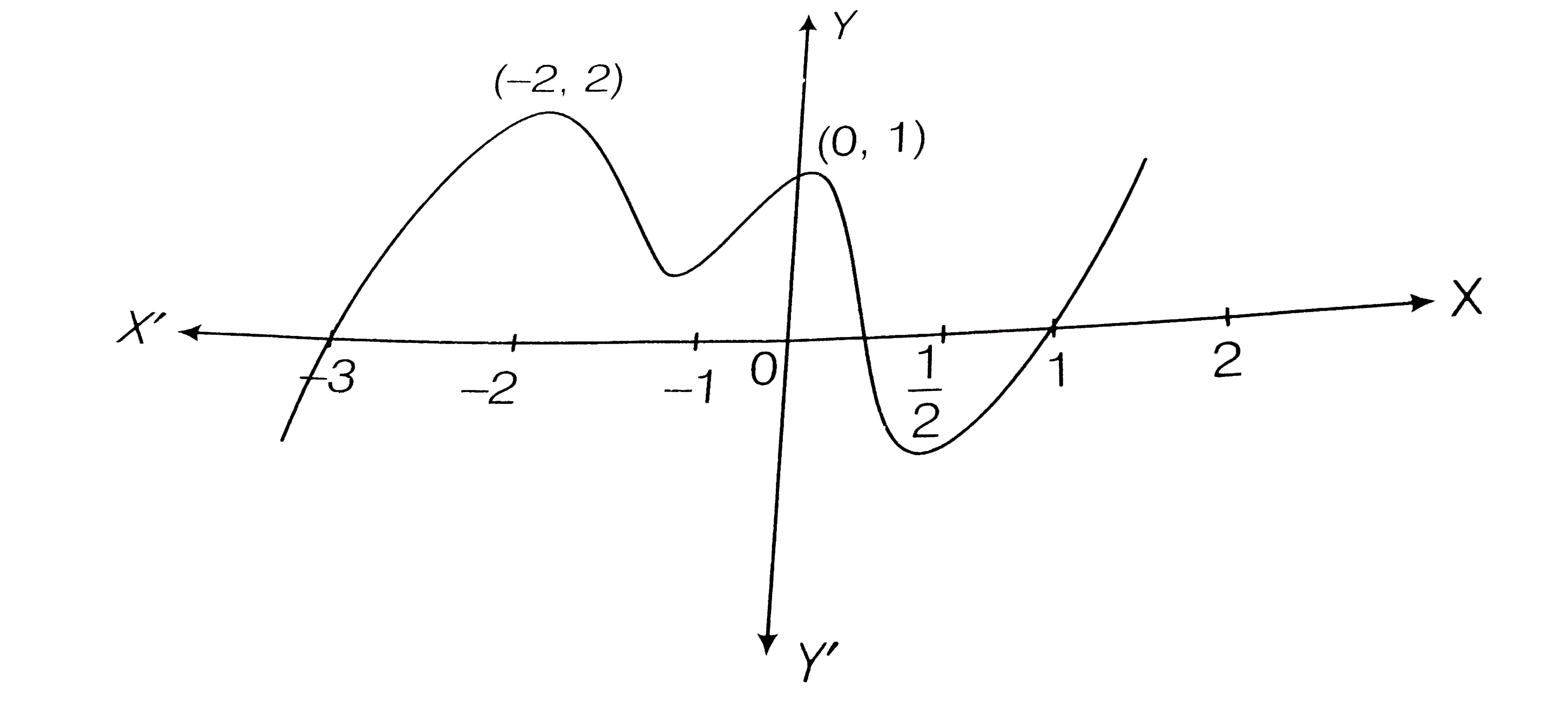Given P(x)=x4+ax3+bx2+cx+d such that x=0 is the only real root of P'(x)=0. If P(−1)<P(1), then in the interval [−1,1]
(a) P(-1) is the minimum and P(1) is the maximum of P
(b) P(-1) is not minimum but P(1) is the maximum of P
(c) P(-1) is not minimum and P(1) is not the maximum of P
(d) neither P(-1) is the minimum nor P(1) is the maximum of P
The correct Answer is:2
P(x)=x4+ax3+bx2+cx+d
P(x)=4x3+3ax2+2bx+c
Since x=0 is solution to P(x) =0 we get c=0 Therefore
P(x)=x4+ax3+bx2+d
Also we have
P(−1)<P(1)
→1−a+b+d<1+a+b+d→a>0
Since P(x) =0 only when x=0 and P(x) is differentiable in
(-1,1) we should have the maximum and minimum points x=-1,0 and 1 only
Also we have f(-1)<P(1)
Maximum of P(x) =maximum {P(0),P(1)}and
Minimum of f(x)=minimum {P(-21),P(0)}
In the interval [0,1]
P(x)=4x3+3ax2+2bx{(p(1)} and
4x2+3ax+2b=0 has no real roots .Therefore
(3a)2−32b<0
→9a232<b
→b>0
Thus we have a>0andbv>0 Thus
P(x) =4x3+3ax2+2bx>0∀x∈(0,1)
Hence P(x) is increasing in [0,1]
Similarly P(x) id P(1)
Therefore the minimum of P(x) does not occur at x=1
Topper's Solved these Questions
- MONOTONICITY AND MAXIMA MINIMA OF FUNCTIONSBOOK - CENGAGE PUBLICATIONCHAPTER - MONOTONICITY AND MAXIMA MINIMA OF FUNCTIONSEXERCISE - Linked comprehension Type
2 Videos
- MONOTONICITY AND MAXIMA MINIMA OF FUNCTIONSBOOK - CENGAGE PUBLICATIONCHAPTER - MONOTONICITY AND MAXIMA MINIMA OF FUNCTIONSEXERCISE - Numerical Value Type
24 Videos
- METHODS OF DIFFERENTIATIONBOOK - CENGAGE PUBLICATIONCHAPTER - METHODS OF DIFFERENTIATIONEXERCISE - Multiple Correct Answer Type
7 Videos
- MONOTONOCITY AND NAXINA-MINIMA OF FUNCTIONSBOOK - CENGAGE PUBLICATIONCHAPTER - MONOTONOCITY AND NAXINA-MINIMA OF FUNCTIONSEXERCISE - Comprehension Type
6 Videos
Similar Questions
Given P(x)=x4+ax3+cx+d such that x=0 is the only real root of P'(x)=0.IfP(1)<P(1) , then in the interval [1,1] . (1) P(1) is the minimum and P(1) is the maximum of P (2) P(1) is not minimum but P(1) is the maximum of P (3) P(1) is the minimum but P(1) is not the maximum of P (4) neither P(1) is the minimum nor P(1) is the maximum of P
View SolutionLet P(x)=x4+ax3+bx2+cx+d, where a,b,c,d∈R.Suppose P(0)=6,P(1)=7,P(2)=8andP(3)=9, then find the value of P(4).
View Solution
Knowledge Check
Given P(x) =x4+ax3+bx2+cx+d such that x=0 is the only real root of P'(x) =0 . If P(-1) < P(1), then in the interval [−1,1]
AP(-1) is the minimum and P(1) is the maximum of PBP(-1) is not minimum but P (1)is the maximum of PCP(-1) is the minimum and P(1) is not the maximum of PDneither P(-1) is the minimum nor P(1) is the maximum of PGiven P(x) =x4+ax3+bx2+cx+d such that x=0 is the only real root of P'(x) =0 . If P(-1) lt P(1),then∈the∫erval[-1,1]
A(a) P(-1) is the minimum and P(1) is the maximum of PB(b) P(-1) is not minimum but P(1) is the maximum of PC(c) P(-1) is not minimum and P(1) is not the maximum of PD(d) neither P(-1) is the minimum nor P(1) is the maximum of PIf x2+x+1 is a factor of ax3+bx2+cx+d, then the real root of ax3+bx2+cx+d=0 is
A−d/aBd/aCa/dDnone of these
If P(x)=x4+ax3+bx2+cx+d,P(1)=P2=P(3)=0 then find P(4)
View SolutionLet P(x)=x4+ax3+bx2+cx+d, where a,b,c,d∈R. Suppose P(0)=6,P(1)=7,P(2)=8 and P(3)=9, then find the value of P(4)
View SolutionLet P(x)=x4+ax3+bx2+cx+d, where a,b,c,d∈R . Suppose P(0)=6,P(1)=7,P(2)=8 and P(3)=9, then find the value of P(4)
View SolutionLet P(x)=x4+ax3+bx2+cx+d be a polynomial such that P(1)=1,P(2)=8,P(3)=27,P(4)=64 then find P(10)
View SolutionIn the given figure graph of y=P(x)=ax5+bx4+cx3+dx2+ex+f, is given.

The minimum number of real roots of equation (P''(x))2+P'(x).P'''(x)=0, is
View Solution
